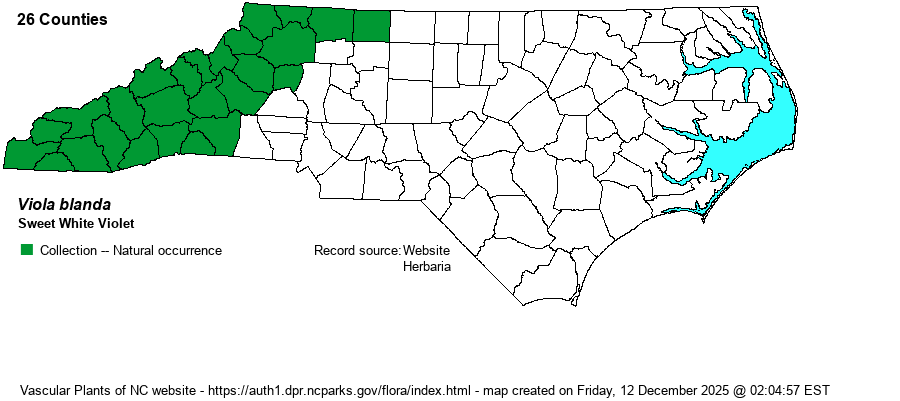| Section 6 » Order Violales » Family Violaceae |
Show/Hide Synonym
| taxonName | relationship | relatedTaxonName | relatedTaxonRefText | relComments |
|---|
|
|
|
|
|
|
| Viola blanda | < | Viola blanda | Gleason and Cronquist (1991) | | | Viola blanda | < | Viola blanda | | | | Viola blanda | < | Viola blanda | Radford, Ahles, and Bell (1968) | | | Viola blanda | < | Viola blanda | Wofford (1989) | | | Viola blanda | < | Viola blanda | Ballard, de Paula-Souza, & Wahlert in Kubitzki (2014). Key adapted, in part, from Ballard (1992) and Ballard & Wujek (1994). | (also see V. incognita) | | Viola blanda | = | Viola blanda var. blanda | | | | Viola blanda | = | Viola blanda var. blanda | | | | Viola blanda | = | Viola blanda var. blanda | Ballard, de Paula-Souza, & Wahlert in Kubitzki (2014). Key adapted, in part, from Ballard (1992) and Ballard & Wujek (1994). | | | Viola blanda | = | Viola blanda var. blanda | Ballard, de Paula-Souza, & Wahlert in Kubitzki (2014). Key adapted, in part, from Ballard (1992) and Ballard & Wujek (1994). | | | Source: Weakley's Flora |
|
| Author | Willdenow | |
| Distribution | Throughout the Mountains and the Piedmont foothills, ranging east to the Sauratown Mountains in Stokes County.
This is a Northern species, occurring south to NJ, PA, and MN, and southward mainly in the Appalachians to northern GA and AL. | |
| Abundance | Common in the Mountains, and fairly common in the Piedmont foothills. The species is widespread enough that the website editors feel that a State Rank of S5 is justified, instead of S4. | |
| Habitat | This is a species of many montane forest types, typically in mesic to rich ones. It is most numerous in the middle and upper elevations, and occurs in Rich Cove Forests, Acidic Cove Forests, Northern Hardwood Forests, and Northern Red Oak Forests, among others. |
| Phenology | Blooms from April to June, and fruits shortly after flowering. | |
| Identification | This is one of a number of white-flowered violets, and many are somewhat similar. This species has typicaly ovate to triangular leaves, dark green and somewhat shiny, about 1-1.5 inches long and wide. The several flowers are on separate stalks (acaulescent species), about 4 inches tall, with white petals. In this species, the leaf blades are somewhat pubescent, at least on the upper side of the basal lobes; V. pallens has completely glabrous leaves above, and tends to grow in seepages or wet places in montane forests. V. pallens usually has a rounded or obtuse leaf tip, as opposed to pointed/acute in V. blanda, and it also has a smaller white flower. V. incognita is very similar to V. blanda; V. blanda has the lateral petals glabrous inside the mouth, versus bearded in V. incognita. V. blanda has the petioles and flower stalks reddish tinged, versus green in V. incognita. Also, V. blanda has the leaf blade tip acute to obtuse, usually coming to a distinct point, whereas the other species has a rounded apex. The latter species usually has leaf pubescence more widespread and not just limited to the basal lobes. As V. incognita is a very rare species in the mountains, when you spot a white-flowered violet in a montane forest, with typical heart-shaped leaves with a somewhat pointed tip, and the flower stalks emerge from the ground on naked stalks, it should be this common and often familiar species. | |
| Taxonomic Comments | None, though V. incognita has often been included with it, as done by RAB (1968).
General note on Viola: In 2009-10 B.A. Sorrie (website map editor) went through the whole collection at NCU, annotating all specimens against those verified by experts in the genus. The range maps in RAB (1968) have been changed accordingly. More recently, Harvey Ballard and colleagues are in the process of revising all Eastern and Southeastern Viola, and have annotated all specimens at NCU in July 2024. They recognize additional species not in RAB or in previous editions of Weakley et al.; we will follow updated editions of Weakley et al. in recognizing them. Species range maps have been adjusted to account for identification changes. | |
| Other Common Name(s) | Woodland White Violet | |
| State Rank | S4 [S5] | |
| Global Rank | G4G5 [G5] | |
| State Status | | |
| US Status | | |
| USACE-agcp | FACW link |
| USACE-emp | FACW link |

